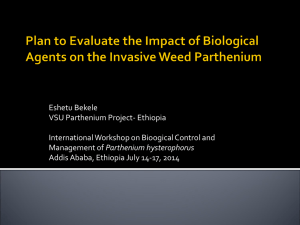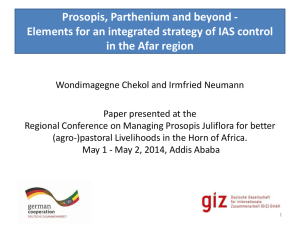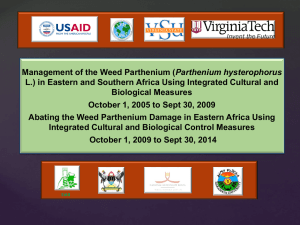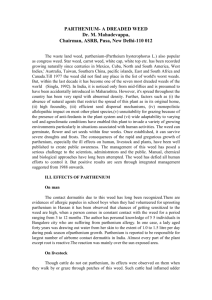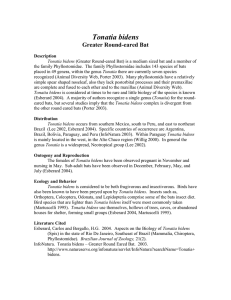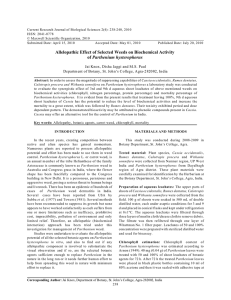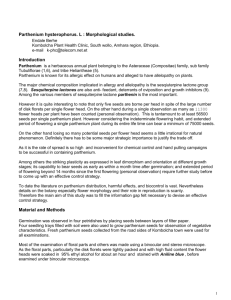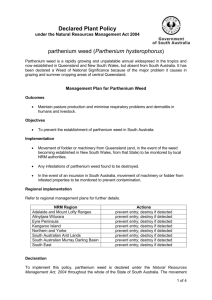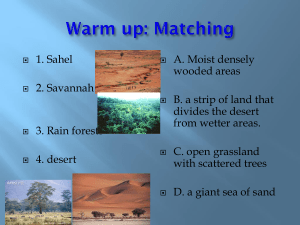03-Alemayehu
advertisement
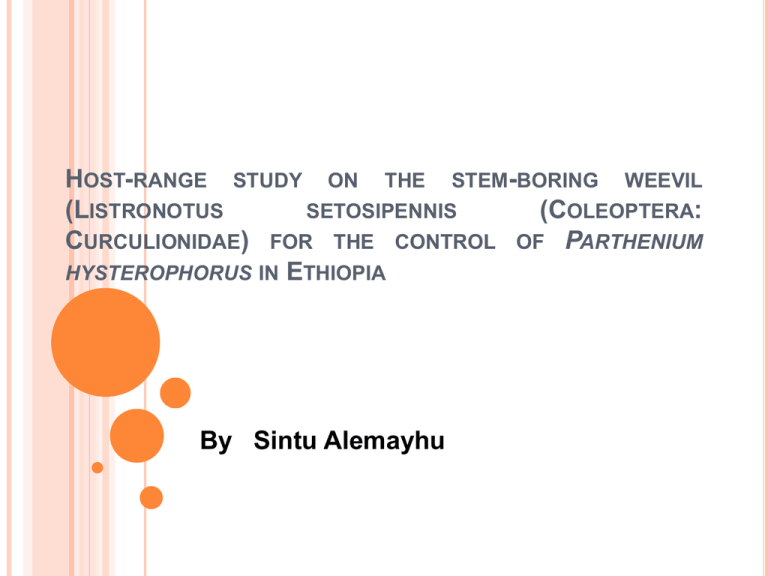
HOST-RANGE STUDY ON THE STEM-BORING WEEVIL (LISTRONOTUS SETOSIPENNIS (COLEOPTERA: CURCULIONIDAE) FOR THE CONTROL OF PARTHENIUM HYSTEROPHORUS IN ETHIOPIA By Sintu Alemayhu OBJECTIVE To evaluate the safety of the stem-boring weevil, Listronotus setosipennis non-target plant species DESCRIPTION AND LIFE CYCLE stem boring weevil Listronotus setosipennis (Hustache) [Coleoptera: Curculionidae] originally from Argentina, were introduced from Agricultural Research Council-Plant Protection Research Institute (ARC-PPRI) of South Africa in December 2009, to be used for studies in Ethiopia Listronotus setosipennis (Coleoptera: Curculionidae Nocturnal adults feed on leaves and flowers Lay eggs in flower heads or leaf bases hatch 3-5 days later pupate in soil inside Complete life cycle of Listronotus takes 30-35 days. fibrous capsules DAMAGE o Adult feeding damage is negligible. o Larval feeding has the ability to kill or prevent further development of parthenium seedlings. In glasshouse conditions, infestation by Listronotus weevil at high densities significantly reduced the plant biomass by 21.9% and flower production by 75%. HOST SPECIFICITY o Host specificity testing is a critically important step in the process of introducing natural enemies for classical weed biological control. o It provides information upon which the suitability of a proposed biological control agent can be assessed (Marohasy1998). CONT… Evaluation of the host range of any bioagent comprises of no-choice tests (test plant species only), followed by choice tests (test plant with Parthenium) if feeding, oviposition or development is observed under no-choice testing on non-target species The safety of Listronotus setosipennis (Hustache) to non-target plants was tested under quarantine on economically important members of the Asteraceae family and indigenous weed species through no-choice tests SELECTION OF NON-TARGET SPECIES The selection of non-target species for host preference testing was made by a taxonomist from Addis Ababa University. The centrifugal phylogenetic method was followed in selecting test plants for testing candidate control agents The test plant species were identified based on how closely related they are to Parthenium, whether they are strictly endemic, near endemic, cultivated, or indigenous to Ethiopia. Figure 1. Diagrammatic representation of the tribe Heliantheae and some crop plants (adapted by Lorraine Strathie from Wapshere, A. J. 1974). MATERIALS AND METHODS Area description The experiment was conducted under quarantine condition at Ambo Plant Protection Research Center (APPRC) 109km West of Addis Ababa. The average temperature is ranges from 10o to 30o C and relative humidity at 50-87 % in the quarantine facility CULTURING OF L. SETOSIPENNIS Adult feeding and oviposition were tested using nylon mesh test cages with metal frames(0.5m x 0.5m x 1m), with two holes for potted plants. All corners and joints were sealed with silicone to prevent escape of weevils through gaps. The safety of Listronotus setosipennis (Hustache) to 39 non-target plants consisting of nineteen major crop species mostly used as food and export Twenty crops and other plant species, belonging to the family Asteraceae which includes two species of Helianthus annus , six species Guizotia abyssinica, both of which are important oil crops in the country . and four species of Bidens CONT… o No-choice tests were designed to test whether the bio-agent feeds, lay eggs and survive on a test plant when it has no access to target weed Parthenium. o All the test plants were grown or transplanted into plastic pots(22cm X 18 cm), containing the mixture of sand 25%, compost/humus 25% and 50% soil o grown up to the required test stage by providing every agronomic management under lath-house CONT… o Healthy and similar size Plant with flowers, were selected and placed in a cage after being washed o Five mating pairs of adult L. setosipennis, obtained from same age group of adults that had been kept for 2-3 weeks, were released into each cage. o Sodium hypochlorite solution (2%) was sprayed on the leaves and soil to prevent any disease occurrence. o The experiment was replicated three times in CRD and one plant per cage was used. CONT… After 7 days of exposure all adults were removed from each test plant and the number of adults that survived, died and missed was recorded All plant parts, including leaf axils, stems and petioles, were carefully examined for ovipostion and feeding. Eggs were counted after dissecting flowers and examining plants under a microscope. •The blue arrow shows frass •The read arrow shows egg Tagetes minuta Helianthus annus (oissa) Bidens pachyloma G.abysinica (kuyyu) Vernonia galamensis Table 1. Result of Host-Specificity of Listronotus setosipennis (Hustache) on major crops No 1. 2. 3. 4. 5. 6. 7. 8. 9. 10. 11. 12. 13. 14. 15. 16. 17. 18. 19 Scientific Name Parthenium hystrerophorous (control) Eragrostis tef Eragrostis tef Sorghum bicolor Zea mays Hordeum vulgare Triticum aestivum Cicer arietinum Lens cultinaris Gossipium sp. Sesamum indicum Sesamum indicum Sesamum indicum Pisum sativum L. Vicia faba Lathyrus sativus Solanum tuberosum Solanum lycopersicum Capsicum sp. Corchorus sp. Common name / variety partehnium Total no of Total mean egg 8648 38.96 S.D S.E 50.01 3.37 Teff Teff v DZ-c37 Sorghum Maize Barley Wheat Chick pea Lentil Cotton var, Arba Sesame var. Abasena var. Tate var.5 Field peas Faba beans Grass pea, Indian vetch Potato local Tomato Pepper 0 0 0 0 0 0 0 0 0 0 0 0 0 0 0 0 0 0 0.00 0.00 0.00 0.00 0.00 0.00 0.00 0.00 0.00 0.00 0.00 0.00 0.00 0.00 0.00 0.00 0.00 0.00 0 0 0 0 0 0 0 0 0 0 0 0 0 0 0 0 0 0 0 0 0.00 0.00 0.00 0.00 0.00 0.00 0.00 0.00 0.00 0.00 0.00 0.00 0.00 0.00 0.00 0.00 0.00 0.00 0.00 0.00 Evaluation of species related to Parthenium Total mean S.D S.E niger seed niger seed niger seed niger seed niger seed niger seed sunflower Total no of egg 0 0 0 0 0 0 0 0 0 0 0 0 0 0 0.00 0.00 0.00 0.00 0.00 0.00 0.00 0.00 0.00 0.00 0.00 0.00 0.00 0.00 Helianthus annuus (R.B) sunflower 0 0 0.00 0.00 9. 10. 11. 12. Carthamus tinctorius Vernonia galamensis Lactuca sativa Safflower Iron Weed Lettuce Bidens pilosa Black jack 0 0 0 0 0 0 0 0 0.00 0.00 0.00 0.00 0.00 0.00 0.00 0.00 13 Bidens Pachyloma Adeyabeba (Amharic) 0 0 0.00 0.00 14 15 16 17. Bidens ghedoensis Bidens sp Guizotia scabra Metch (Amharic) Conyza bonariensis Horseweed, Asthmaweed 0 0 0 0 0 0 0 0 0.00 0.00 0.00 0.00 0.00 0.00 0.00 0.00 18. 19. Galinsoga parviflora Tagetes minuta 0 0 0 0 0.00 0.00 0.00 0.00 20. 21. Flaveria trinervia Parthenium hysterophorus Gallant soldier Black mint Clustered yellow tops parthenium 0 8648 0 38.96 0.00 50.01 0.00 3.37 No Scientific/variety name Common name 1. 2. 3. 4. 5. 6. 7. Guizotia abyssinica (Local) G. abyssinica (Fogera) G. abyssinica (ESTE) G. abyssinica (Kuyu) G. abyssinica (Shambu) G. abyssinica (Ghinchi) Helianthus annuus (oissa) 8. CONCLUSION The concern that the agent, Listronotus setosipennis, might attack non- target crops and plants was resolved through a quarantine test against crops and plants that are closely related to Parthenium and others that are economically important and indigenous to Ethiopia. Therefore there was no need to go for choice test since no oviposition took place in no choice test
